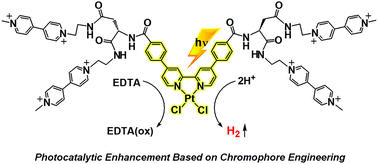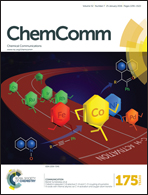Photochemical H2 evolution from water catalyzed by a dichloro(diphenylbipyridine)platinum(ii) derivative tethered to multiple viologen acceptors†
Abstract
A new single-component photocatalyst for the reduction of water to H2, a dichloro(dpbpy)platinum(II) derivative (dpbpy = 4,4′-diphenyl-2,2′-bipyridine) tethered to four pendant viologen acceptors (1), is shown to exhibit twice higher photocatalytic efficiency than the previously reported dichloro(bpy)-platinum(II) analog (2; bpy = 2,2′-bipyridine), consistent with the higher absorptivity of 1 at the metal-to-ligand charge transfer (1MLCT) band due to the larger π-conjugation in dpbpy relative to bpy.


 Please wait while we load your content...
Please wait while we load your content...